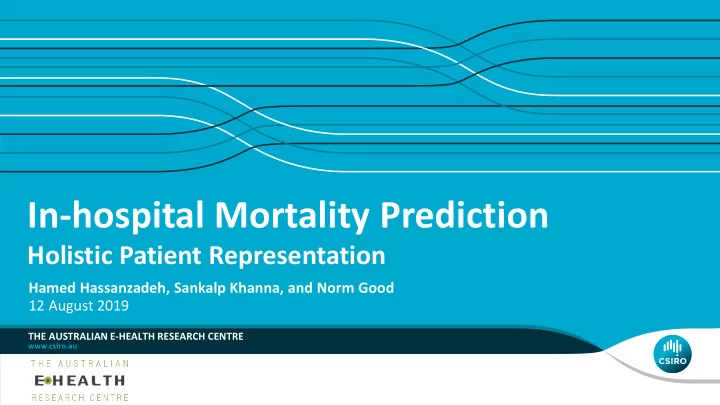

In-hospital Mortality Prediction Holistic Patient Representation Hamed Hassanzadeh, Sankalp Khanna, and Norm Good 12 August 2019 THE AUSTRALIAN E-HEALTH RESEARCH CENTRE
Who we are? • Health System Analytics – Resource management – Demand forecasting – Modelling and Simulation – Risk Stratification – Clinical Decision Support – etc. 2 | Longitudinal Patients Phenotyping and Representation for Patient-level Predictions| Hamed Hassanzadeh
In-hospital Mortality • Risk factors • Clinical conditions • Patient characteristics • Patient history – Disease trajectory – Number of admissions – etc. 3 | Longitudinal Patients Phenotyping and Representation for Patient-level Predictions| Hamed Hassanzadeh
Patient Representation • From patient records to predictive models – Model processable format (numerical feature vector representation) – Numerical values – this is OK – Categorical values ?? – Unstructured text ?? – Longitudinal information ?? 4 | Longitudinal Patients Phenotyping and Representation for Patient-level Predictions| Hamed Hassanzadeh
Traditional Representation • Dummy variables – Type of admission Elective Non-elective 1 0 0 1 AGE LT40 AGE 40-60 AGE 60-80 AGE GT80 0 1 0 0 0 0 1 0 – Age Range 0 0 0 1 1 0 0 0 AORTIC BILATERAL FLUCONAZOLE MYOCARDIAL PULMONARY SEIZURE-MRSA IN SHORTNESS OF … DISSECTION PNEUMONIA DESENSITIZATION INFARCTION VASCULITIS SPUTUM BREATH 0 1 0 0 0 0 0 0 0 0 0 0 0 0 – Diagnoses 0 0 0 0 0 0 0 0 0 0 0 1 0 0 0 0 0 1 0 0 0 1 0 0 0 0 0 0 0 0 0 0 0 0 1 0 0 0 0 0 1 0 0 0 0 0 0 0 0 0 0 1 0 0 0 0 5 | Longitudinal Patients Phenotyping and Representation for Patient-level Predictions| Hamed Hassanzadeh
Electronic Health Records (EHR) • Longitudinal • Structured • Unstructured 6 | Longitudinal Patients Phenotyping and Representation for Patient-level Predictions| Hamed Hassanzadeh
Methodology • Holistic approach – Structured & unstructured – Full potential of categorical variables – Longitudinal information • Artificial Neural Network Vector Representation – Vector Space Models – Unsupervised Feature Learning 7 | Longitudinal Patients Phenotyping and Representation for Patient-level Predictions| Hamed Hassanzadeh
Flashback – HIC18 • Vector representation – Embedding Models – Contextual information 8 | Longitudinal Patients Phenotyping and Representation for Patient-level Predictions| Hamed Hassanzadeh
Methodology (cont.) • Predictive models – Naïve Bayes – Stochastic Gradient Descend – Random Forest – Multi-layer Perceptron 9 | Longitudinal Patients Phenotyping and Representation for Patient-level Predictions| Hamed Hassanzadeh
Data • MIMIC III Dataset – 58976 hospital encounters – 46520 unique patients – 70% non-elective patients (n=32610) – 17% of these non-elective patients have been re-admitted (n=5475) – 41% of the re-admitted patients (n=2264) had an adverse event of in- hospital mortality (1283 male and 981 female). 10 | Longitudinal Patients Phenotyping and Representation for Patient-level Predictions| Hamed Hassanzadeh
Data Analysis Age Range Distribution of Re admitted Patients Died in Hospital Females Age Range Distribution of Re admitted Patients Died in Hospital Males 350 350 300 300 250 250 200 Count Count 200 150 150 100 100 50 50 0 0 20 40 60 80 20 30 40 50 60 70 80 90 Age Range Age Range Re admissions Frequency among Males and Females Male 64% Female 400 Number of Unique Encounters 62% 300 200 19% 100 20% 9% 5% 3% 2% 2% 1% 1% 8% 1% 0% 1% 1% 0% 0% 0 2 4 6 8 10 Number of Re admissions 11 | Longitudinal Patients Phenotyping and Representation for Patient-level Predictions| Hamed Hassanzadeh
Data Analysis (Disease Prevalence) XIV: Congenital Anomalies I: Infectious And Parasitic Diseases XVI: Symptoms, Signs, And Ill Defined Conditions X: Diseases Of The Genitourinary System XVIII: Supplementary Classification Of Factors Influencing Health Status And Contact With Health Services XII: Diseases Of The Skin And Subcutaneous Tissue VII: Diseases Of The Circulatory System III: Endocrine, Nutritional And Metabolic Diseases, And Immunity Disorders XIII: Diseases Of The Musculoskeletal System And Connective Tissue VIII: Diseases Of The Respiratory System V: Mental Disorders VI: Diseases Of The Nervous System And Sense Organs IX: Diseases Of The Digestive System IV: Diseases Of The Blood And Blood Forming Organs XVII: Injury And Poisoning II: Neoplasms 12 | Longitudinal Patients Phenotyping and Representation for Patient-level Predictions| Hamed Hassanzadeh
Early Results • Results on MIMIC III Model Male Female Precision Recall F1-Score Precision Recall F1-Score Naïve Bayes 0.6838 0.7311 0.7067 0.6889 0.729 0.7084 Stochastic Gradient Descend 0.7393 0.7257 0.7324 0.7187 0.7137 0.7162 Random Forest 0.6654 0.5245 0.5866 0.6408 0.5194 0.5738 Multi-layer Perceptron 0.7554 0.7567 0.7560 0.7441 0.723 0.7334 13 | Longitudinal Patients Phenotyping and Representation for Patient-level Predictions| Hamed Hassanzadeh
Conclusion • Comprehensive patient information representation • Promising approach for patient-level risk stratification • Future work: – Incorporating more information from EHR (e.g., vital signs) – Improve explainability of our approach – Validation on more hospitals’ data 14 | Longitudinal Patients Phenotyping and Representation for Patient-level Predictions| Hamed Hassanzadeh
Thank you Hamed Hassanzadeh, PhD Research Scientist hamed.hassanzadeh@csiro.au Come and visit us at the CSIRO booth # 35 Our researchers and scientists would love to share more with you about how their work is enabling digital health in Australia and around the world. HEALTH & BIOSECURITY
Recommend
More recommend